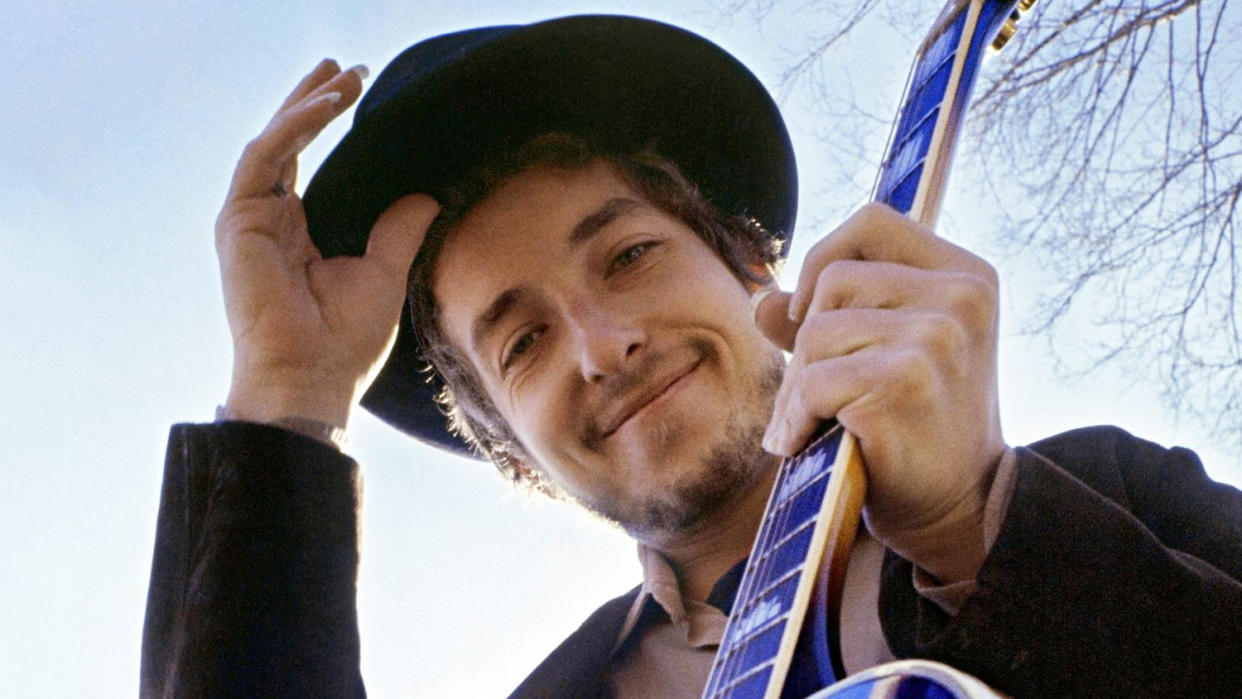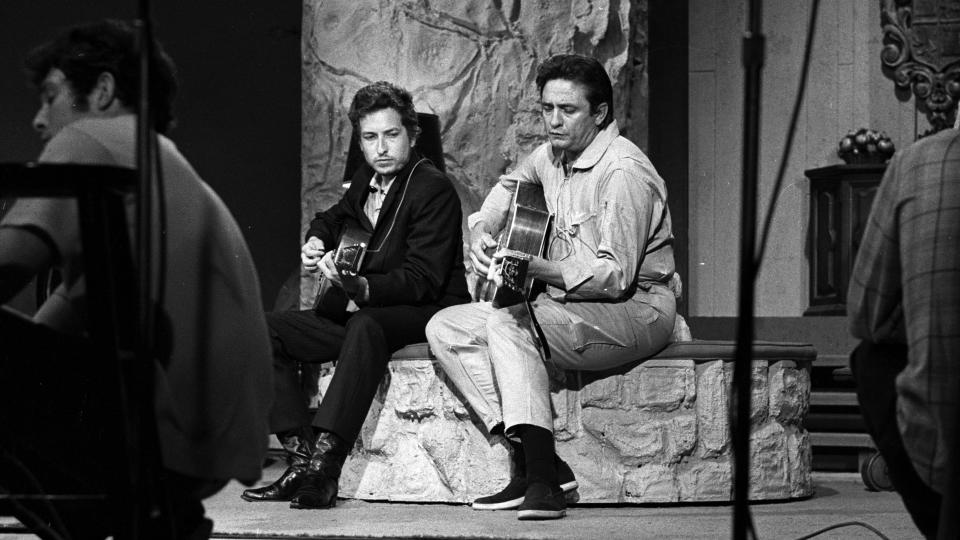The Bob Dylan album that helped change country music

On 7 June, 1969 Bob Dylan walked out onto the sound stage at the first edition of The Johnny Cash Show, ABC’s new TV music variety special, taped at Nashville’s Ryman Auditorium, home of the Grand Ole Opry. The set was a mock-up of a large rustic living room, with bare stone walls, bold soft furnishings, a grandfather clock and some ornate baronial touches. Dylan played three songs that day including a duet with Johnny Cash on Girl From The North Country, a song that appeared on Dylan’s ninth studio album, Nashville Skyline.
The event marked the culmination of a friendship and mutual admiration that started back in 1964. In his memoir Cash: The Autobiography, the late country legend recalled taking a portable record player out on tour in 1963 and playing The Freewheelin’ Bob Dylan album backstage, before and after each of his shows. Cash went on to include three Dylan songs – It Ain’t Me Babe, Mama You’ve Been On My Mind and Don't Think Twice, It's All Right – on his 1965 album, Orange Blossom Special.

In turn, Dylan was a huge fan of Cash’s work, since first hearing I Walk The Line. When Cash died in 2003, Dylan paid a moving tribute: “In plain terms, Johnny was and is the North Star; you could guide your ship by him — the greatest of the greats then and now.”
Cash’s endorsement had a significant impact on how Dylan was perceived within country music and the mainstream. Nashville Skyline would become one of Dylan’s best-selling albums. It would also play a pivotal role in helping to establish country and country rock as a vital new force within popular music.
The country music scene of 1969 was still deeply conservative and steeped in traditional values, but things were on the cusp of change
Dylan’s first foray into country and roots music had occurred black in early 1966, when he recorded at Columbia studios in Nashville, for the double album Blonde On Blonde (June 1966). It was a direction he would continue with the follow-up John Wesley Harding (1967). But it was Nashville Skyline that would become his first fully-fledged country album.
The country music scene of 1969 was still deeply conservative and steeped in traditional values, but things were on the cusp of change. While the counterculture of Laurel Canyon was light years away from the orthodoxy of Nashville, country music was fuelling the creative visions of singer-songwriters such as Gram Parsons.
The trust fund-empowered Parsons had already pulled The Byrds in that direction on their 1968 album Sweetheart Of The Rodeo – an album that featured the Dylan-penned You Ain't Goin' Nowhere as its opener. Meanwhile, in upstate New York, The Band went back to the land, drawing on country, folk and bluegrass among other influences on their debut 1968 album, Music From The Big Pink. Dylan would spend many evenings with The Band, talking, drinking and running through old folk songs.
Like many of his generation, Dylan had grown up on Western movies and the traditional folk songs of ‘singing cowboys’ such as Gene Autrey and Roy Rogers. On Nashville Skyline, Dylan documents the fading West, looking back towards tradition and a sense of roots. He also uses more basic lyrical themes and simpler songwriting structures.
The sessions for Nashville Skyline took place from 12 to 21 June, 1969. at Studio A, Columbia Studios in Nashville. The producer was Bob Johnston, who had worked with Dylan on Blonde On Blonde and John Wesley Harding. Dylan used some of the finest session musicians on the Nashville scene, such as Charlie McCoy (guitar, harmonica), Pete Drake (pedal steel), Norman Blake (guitar, dobro) and Kenneth A Buttrey (drums, bongos and cowbell). Another session player, who would go on to find success in his own right, was Charlie Daniels, enlisted here on bass guitar and guitar.
Daniels recalled the anticipation of meeting Bob Dylan for the first time, in an interview with Steve Wosahla in 2019 on the Americana Highways website. “So much has been written about him, I didn’t know what he was going to be like. But he was just like everyone else and had a great sense of humour.”
Daniels was initially only booked for the first day to replace a musician who hadn’t showed up. When he packed up his guitar and started to leave, Dylan reportedly asked Bob Johnston 'Where’s he going?'
When Johnston told Dylan that Daniels was finished, Dylan replied: 'I don’t want another guitar player. I want him.' Daniels ended up staying for the entire album.
Nashville session guitarist Charlie McCoy had already met Dylan back in 1965, when McCoy travelled up to New York, lured by the promise of tickets for a Broadway show from Bob Johnston, who was staff producer at Columbia Records in New York.
Dylan just happened to be recording the album Highway 61 Revisited when McCoy dropped by the studio. According to Steve Wosahla, Dylan said to McCoy “I’m getting ready to do a song. Why don’t you pick up a guitar?”. McCoy did exactly that, not realising that the song, Desolation Row, would last eleven minutes. McCoy’s licks would all be used on the finished track.
On 17 and 18 June, Johnny Cash arrived in Nashville to record with Dylan. Producer Bob Johnson hoped that these sessions alone would yield enough for a whole album. They recorded 15 songs but only one would be selected; Girl From The North Country.
Dylan wrote the song when he visited England in late 1962 and met folk revivalist Martin Carthy, who exposed him to several traditional English folk songs, which Dylan used to inform Girl From The North Country. Carthy showed Dylan his own song Scarborough Fair and Dylan used the melody and lyrics, specifically the line “Remember me to one who lives there, she once was a true love of mine”.
The song first appeared on Dylan’s second album The Freewheelin’ Bob Dylan (1963) but this duet with Cash has a unique resonance. Dylan and Cash’s vocals are soaked in deep, lush reverb and there’s a subtle, strident skip and groove to the acoustic guitar performances. Dylan and Cash’s vocals are instinctive and spontaneous. Neither is sticking to any script and it’s all the better for it.
One of the most noticeable things for any Dylan fan dropping the needle onto this album for the first time was Dylan’s voice. Gone was the uniquely gravelly and nasal timbre for which he was known. In its place there was a smooth baritone country croon, which some critics argued was a result of his having quit smoking.
Some found it contrived and irritating, but there’s no doubt it works for the material here. As Stephen Thomas Erlewine of AllMusic put it in a retrospective review: “The sound of his voice is so different it may be disarming upon first listen, but it suits the songs.”
There’s a warm, friendly feel to this album. There’s also a sense of fun, reflected by Dylan’s cheeky grin beaming out from the cover. Songs are short and direct, leading to a total running time of just 26 minutes and 46 seconds.
Girl From The North Country is a strong opener and really sets the tone. The union of Dylan’s poeticism and a regret-strewn Nashville narrative on the Dylan/Cash co-write I Threw It All Away is beguiling, while the presence of organ adds a gospel feel. “Once I had mountains in the palm of my hand / And rivers that ran through every day / I must have been mad / I never knew what I had / Until I threw it all away”.
Organ also underpins Lay Lady Lay, one of the album’s truly great moments, a glorious paean to love and lust which is elevated by Pete Drake’s mournful pedal steel. It’s a wonderfully floating melody and the song on which Dylan’s purer country crooning style really does bear fruit. “Why wait any longer for the one you love / When he’s standing right in front of you…”
Critics and fans have pondered at length over who the song is about although in a 1971 interview, Dylan did casually mention that it “was written for Barbra Streisand”.
Another standout track is the closer, Tonight I'll Be Staying Here With You. Dylan had arrived at the Nashville Skyline sessions with just four songs, including I Threw It All Away and Lay Lady Lay. He recorded these and three other new tracks on 13 and 14 February, 1969. He then set about creating the rest of the songs and wrote Tonight I'll Be Staying Here With You over the course of two days at the Ramada Inn, where he was staying. The track was recorded across 11 takes on 17 February.
This song marks a change for Dylan. Instead of documenting a restless quest for perfect love, the lyric expresses a willingness to stay with one partner.
There’s a dreamy, easy-going feel, a sense of gleefully casting off cares and responsibilities. Piano and pedal steel are defining features of the song, which has a slow, mellow groove. Yes, it’s country but it’s so much more. Like all great art, Dylan takes the elements and creates something new. It’s a spirited, stately close to the album.
He opened all the doors in Nashville when he did Blonde On Blonde and Nashville Skyline
Nashville Skyline was released on 9 April, 1969, and was warmly received in the press. Paul Nelson of Rolling Stone concluded that “Nashville Skyline achieves the artistically impossible: a deep, humane, and interesting statement about being happy. It could well be... his best album”. Newsweek meanwhile highlighted “the great charm... and the ways Dylan, both as composer and performer, has found to exploit subtle differences on a deliberately limited emotional and verbal scale.”
Nashville Skyline would go on to become one of Dylan's best-selling albums, yielding three singles – I Threw It All Away, Lay Lady Lay and Tonight I’ll Be Staying Here With you – all of which received significant airplay on AM radio. The album marked a turning point in transforming the perceptions of the country music capital. It also helped broaden and pave the way for a whole generation of artists who would follow in his wake.
"Our generation owes him our artistic lives," observed Kris Kristofferson, "because he opened all the doors in Nashville when he did Blonde On Blonde and Nashville Skyline. The country scene was so conservative until he arrived. He brought in a whole new audience. He changed the way people thought about it – even the Grand Ole Opry was never the same again.”

 Yahoo News
Yahoo News 